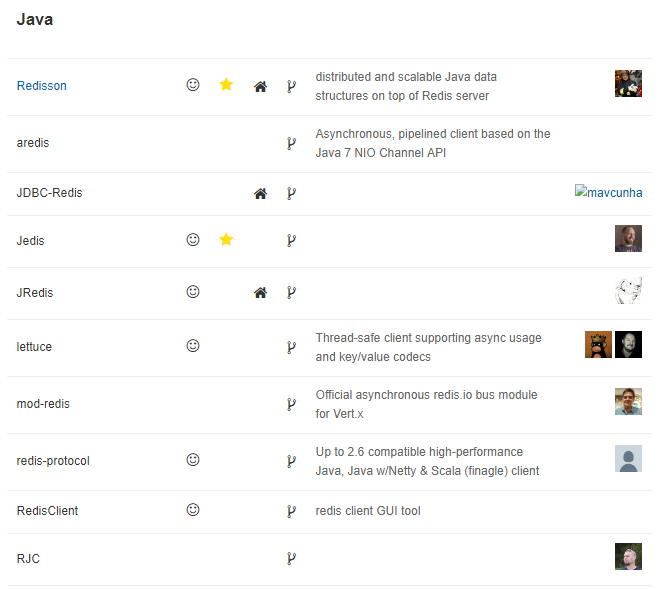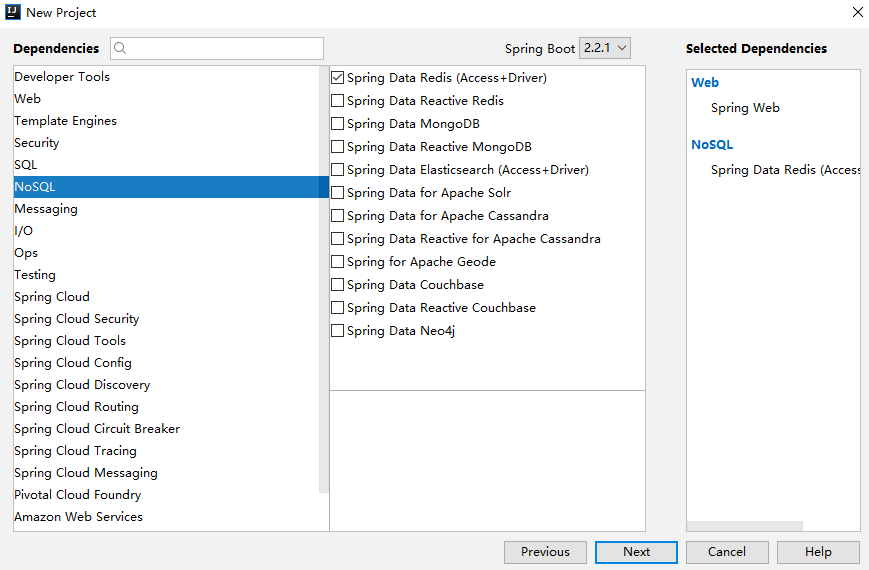Spring Boot2 系列教程(二十六)Spring Boot 整合 Redis
声明
本系列第 24、25 两篇文章,分别是 Spring Boot+Jpa 以及 Spring Boot+Jpa 多数据源,不知触发了什么关键字,一直无法发送,找了半天也没找到违规的字词,所以,这两篇文章大家有兴趣可以去我的博客上查看:http://springboot.javaboy.org,本文就直接跳到第 26 篇了
在 Redis 出现之前,我们的缓存框架各种各样,有了 Redis ,缓存方案基本上都统一了,关于 Redis,松哥之前有一个系列教程,尚不了解 Redis 的小伙伴可以参考这个教程:
-
Redis 教程合集
使用 Java 操作 Redis 的方案很多,Jedis 是目前较为流行的一种方案,除了 Jedis ,还有很多其他解决方案,如下:

除了这些方案之外,还有一个使用也相当多的方案,就是 Spring Data Redis。
在传统的 SSM 中,需要开发者自己来配置 Spring Data Redis ,这个配置比较繁琐,主要配置 3 个东西:连接池、连接器信息以及 key 和 value 的序列化方案。
在 Spring Boot 中,默认集成的 Redis 就是 Spring Data Redis,默认底层的连接池使用了 lettuce ,开发者可以自行修改为自己的熟悉的,例如 Jedis。
Spring Data Redis 针对 Redis 提供了非常方便的操作模板 RedisTemplate 。这是 Spring Data 擅长的事情,那么接下来我们就来看看 Spring Boot 中 Spring Data Redis 的具体用法。
方案一:Spring Data Redis
创建工程
创建工程,引入 Redis 依赖:

创建成功后,还需要手动引入 commos-pool2 的依赖,因此最终完整的 pom.xml 依赖如下:
<dependencies>
<dependency>
<groupId>org.springframework.boot</groupId>
<artifactId>spring-boot-starter-data-redis</artifactId>
</dependency>
<dependency>
<groupId>org.springframework.boot</groupId>
<artifactId>spring-boot-starter-web</artifactId>
</dependency>
<dependency>
<groupId>org.apache.commons</groupId>
<artifactId>commons-pool2</artifactId>
</dependency>
</dependencies>
这里主要就是引入了 Spring Data Redis + 连接池。
配置 Redis 信息
接下来配置 Redis 的信息,信息包含两方面,一方面是 Redis 的基本信息,另一方面则是连接池信息:
spring.redis.database=0 spring.redis.password=123 spring.redis.port=6379 spring.redis.host=192.168.66.128 spring.redis.lettuce.pool.min-idle=5 spring.redis.lettuce.pool.max-idle=10 spring.redis.lettuce.pool.max-active=8 spring.redis.lettuce.pool.max-wait=1ms spring.redis.lettuce.shutdown-timeout=100ms
自动配置
当开发者在项目中引入了 Spring Data Redis ,并且配置了 Redis 的基本信息,此时,自动化配置就会生效。
我们从 Spring Boot 中 Redis 的自动化配置类中就可以看出端倪:
@Configuration
@ConditionalOnClass(RedisOperations.class)
@EnableConfigurationProperties(RedisProperties.class)
@Import({ LettuceConnectionConfiguration.class, JedisConnectionConfiguration.class })
public class RedisAutoConfiguration {
@Bean
@ConditionalOnMissingBean(name = "redisTemplate")
public RedisTemplate<Object, Object> redisTemplate(
RedisConnectionFactory redisConnectionFactory) throws UnknownHostException {
RedisTemplate<Object, Object> template = new RedisTemplate<>();
template.setConnectionFactory(redisConnectionFactory);
return template;
}
@Bean
@ConditionalOnMissingBean
public StringRedisTemplate stringRedisTemplate(
RedisConnectionFactory redisConnectionFactory) throws UnknownHostException {
StringRedisTemplate template = new StringRedisTemplate();
template.setConnectionFactory(redisConnectionFactory);
return template;
}
}
这个自动化配置类很好理解:
-
首先标记这个是一个配置类,同时该配置在 RedisOperations 存在的情况下才会生效(即项目中引入了 Spring Data Redis)
-
然后导入在 application.properties 中配置的属性
-
然后再导入连接池信息(如果存在的话)
-
最后,提供了两个 Bean ,RedisTemplate 和 StringRedisTemplate ,其中 StringRedisTemplate 是 RedisTemplate 的子类,两个的方法基本一致,不同之处主要体现在操作的数据类型不同,RedisTemplate 中的两个泛型都是 Object ,意味者存储的 key 和 value 都可以是一个对象,而 StringRedisTemplate 的 两个泛型都是 String ,意味者 StringRedisTemplate 的 key 和 value 都只能是字符串。如果开发者没有提供相关的 Bean ,这两个配置就会生效,否则不会生效。
使用
接下来,可以直接在 Service 中注入 StringRedisTemplate 或者 RedisTemplate 来使用:
@Service
public class HelloService {
@Autowired
RedisTemplate redisTemplate;
public void hello() {
ValueOperations ops = redisTemplate.opsForValue();
ops.set("k1", "v1");
Object k1 = ops.get("k1");
System.out.println(k1);
}
}
Redis 中的数据操作,大体上来说,可以分为两种:
-
针对 key 的操作,相关的方法就在 RedisTemplate 中
-
针对具体数据类型的操作,相关的方法需要首先获取对应的数据类型,获取相应数据类型的操作方法是 opsForXXX
调用该方法就可以将数据存储到 Redis 中去了,如下:

k1 前面的字符是由于使用了 RedisTemplate 导致的,RedisTemplate 对 key 进行序列化之后的结果。
RedisTemplate 中,key 默认的序列化方案是 JdkSerializationRedisSerializer 。
而在 StringRedisTemplate 中,key 默认的序列化方案是 StringRedisSerializer ,因此,如果使用 StringRedisTemplate ,默认情况下 key 前面不会有前缀。
不过开发者也可以自行修改 RedisTemplate 中的序列化方案,如下:
@Service
public class HelloService {
@Autowired
RedisTemplate redisTemplate;
public void hello() {
redisTemplate.setKeySerializer(new StringRedisSerializer());
ValueOperations ops = redisTemplate.opsForValue();
ops.set("k1", "v1");
Object k1 = ops.get("k1");
System.out.println(k1);
}
}
当然也可以直接使用 StringRedisTemplate:
@Service
public class HelloService {
@Autowired
StringRedisTemplate stringRedisTemplate;
public void hello2() {
ValueOperations ops = stringRedisTemplate.opsForValue();
ops.set("k2", "v2");
Object k1 = ops.get("k2");
System.out.println(k1);
}
}
另外需要注意 ,Spring Boot 的自动化配置,只能配置单机的 Redis ,如果是 Redis 集群,则所有的东西都需要自己手动配置,关于如何操作 Redis 集群,松哥以后再来和大家分享。
方案二:Spring Cache
通过 Spring Cache 的形式来操作 Redis,Spring Cache 统一了缓存江湖的门面,这种方案,松哥之前有过一篇专门的文章介绍,小伙伴可以移步这里: Spring Boot中,Redis缓存还能这么用! 。
方案三:回归原始时代
第三种方案,就是直接使用 Jedis 或者 其他的客户端工具来操作 Redis ,这种方案在 Spring Boot 中也是支持的,虽然操作麻烦,但是支持,这种操作松哥之前也有介绍的文章,因此这里就不再赘述了,可以参考Jedis 使用。
总结
Spring Boot 中,Redis 的操作,这里松哥给大家总结了三种方案,实际上前两个使用广泛一些,直接使用 Jedis 还是比较少,基本上 Spring Boot 中没见过有人直接这么搞。
好了,本文就说到这里,有问题欢迎留言讨论。
相关案例已经上传到 GitHub,欢迎小伙伴们们下载:https://github.com/lenve/javaboy-code-samples


1 、 Spring Boot2 系列教程(一)纯 Java 搭建 SSM 项目
2、 Spring Boot2 系列教程(二)创建 Spring Boot 项目的三种方式
3、 Spring Boot2 系列教程(三)理解 spring-boot-starter-parent
4、 Spring Boot2 系列教程(四)理解配置文件 application.properties !
5、 Spring Boot2 系列教程(五)Spring Boot中的 yaml 配置
6、 Spring Boot2 系列教程(六)自定义 Spring Boot 中的 starter
7、 Spring Boot2 系列教程(七)理解自动化配置的原理
14、 Spring Boot2 系列教程(十四)CORS 解决跨域问题
16、 Spring Boot2 系列教程(十六)定时任务的两种实现方式
21、 Spring Boot2 系列教程(二十一)整合 MyBatis
23、 Spring Boot2 系列教程(二十三)理解 Spring Data Jpa

喜欢就点个 "在看" 呗^_^
- 本文标签: 连接池 自动化 配置 XML dist connectionFactory springboot db 集群 App Connection JPA Spring Boot tab cat CTO 总结 下载 id web tar GitHub 开发 文章 IO apache https redis dependencies Word cache java git 数据 mybatis 博客 tk spring 开发者 value http bean 缓存 pom UI key src Service
- 版权声明: 本文为互联网转载文章,出处已在文章中说明(部分除外)。如果侵权,请联系本站长删除,谢谢。
- 本文海报: 生成海报一 生成海报二











![[HBLOG]公众号](https://www.liuhaihua.cn/img/qrcode_gzh.jpg)

